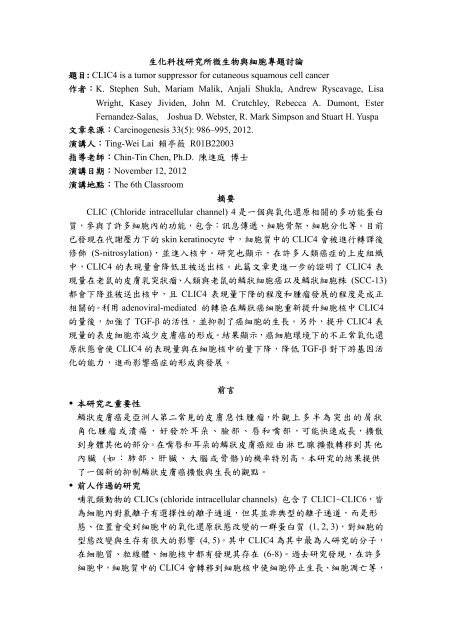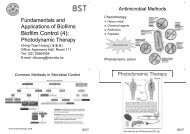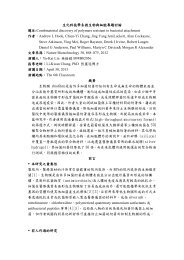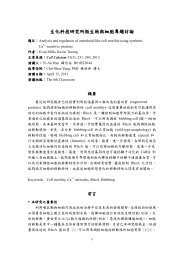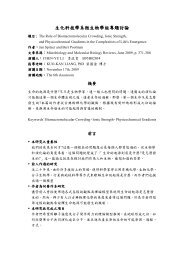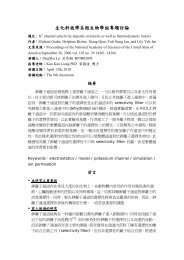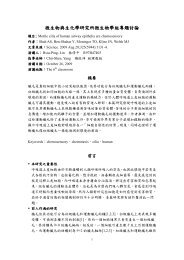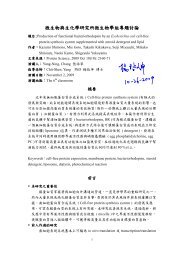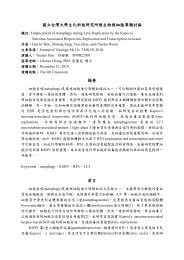賴亭薇
賴亭薇
賴亭薇
Create successful ePaper yourself
Turn your PDF publications into a flip-book with our unique Google optimized e-Paper software.
生化科技研究所微生物與細胞專題討論<br />
題目: CLIC4 is a tumor suppressor for cutaneous squamous cell cancer<br />
作者:K. Stephen Suh, Mariam Malik, Anjali Shukla, Andrew Ryscavage, Lisa<br />
Wright, Kasey Jividen, John M. Crutchley, Rebecca A. Dumont, Ester<br />
Fernandez-Salas, Joshua D. Webster, R. Mark Simpson and Stuart H. Yuspa<br />
文章來源:Carcinogenesis 33(5): 986–995, 2012.<br />
演講人:Ting-Wei Lai <strong>賴亭薇</strong> R01B22003<br />
指導老師:Chin-Tin Chen, Ph.D. 陳進庭 博士<br />
演講日期:November 12, 2012<br />
演講地點:The 6th Classroom<br />
摘要<br />
CLIC (Chloride intracellular channel) 4 是一個與氧化還原相關的多功能蛋白<br />
質,參與了許多細胞內的功能,包含:訊息傳遞、細胞骨架、細胞分化等。目前<br />
已發現在代謝壓力下的 skin keratinocyte 中,細胞質中的 CLIC4 會被進行轉譯後<br />
修飾 (S-nitrosylation),並進入核中。研究也顯示,在許多人類癌症的上皮組織<br />
中,CLIC4 的表現量會降低且被送出核。此篇文章更進一步的證明了 CLIC4 表<br />
現量在老鼠的皮膚乳突狀瘤、人類與老鼠的鱗狀細胞癌以及鱗狀細胞株 (SCC-13)<br />
都會下降並被送出核中,且 CLIC4 表現量下降的程度和腫瘤發展的程度是成正<br />
相關的。利用 adenoviral-mediated 的轉染在鱗狀癌細胞重新提升細胞核中 CLIC4<br />
的量後,加強了 TGF-β 的活性,並抑制了癌細胞的生長。另外,提升 CLIC4 表<br />
現量的表皮細胞亦減少皮膚癌的形成。結果顯示,癌細胞環境下的不正常氧化還<br />
原狀態會使 CLIC4 的表現量與在細胞核中的量下降,降低 TGF-β 對下游基因活<br />
化的能力,進而影響癌症的形成與發展。<br />
本研究之重要性<br />
前言<br />
鱗狀皮膚癌是亞洲人第二常見的皮膚惡性腫瘤,外觀上多半為突出的屑狀<br />
角化腫瘤或潰瘍,好發於耳朵、臉部、唇和嘴部,可能快速成長,擴散<br />
到身體其他的部分。在嘴唇和耳朵的鱗狀皮膚癌經由淋巴腺擴散轉移到其他<br />
內臟 (如:肺部、肝臟、大腦或骨骼)的機率特別高。本研究的結果提供<br />
了一個新的抑制鱗狀皮膚癌擴散與生長的觀點。<br />
前人作過的研究<br />
哺乳類動物的 CLICs (chloride intracellular channels) 包含了 CLIC1~CLIC6,皆<br />
為細胞內對氯離子有選擇性的離子通道,但其並非典型的離子通道,而是形<br />
態、位置會受到細胞中的氧化還原狀態改變的一群蛋白質 (1, 2, 3),對細胞的<br />
型態改變與生存有很大的影響 (4, 5)。其中 CLIC4 為其中最為人研究的分子,<br />
在細胞質、粒線體、細胞核中都有發現其存在 (6-8)。過去研究發現,在許多<br />
細胞中,細胞質中的 CLIC4 會轉移到細胞核中使細胞停止生長、細胞凋亡等,
且核中的 CLIC4 是經由增強 TGF-β 訊息傳導路徑來達到上述目的 (9)。然而,<br />
在人類癌細胞中,CLIC4 會被送出核外,且在腫瘤的上皮組織中,表現量會降<br />
低 (10)。<br />
作者為何要作本研究<br />
有鑑於 CLIC4 的表現量與位置在腫瘤組織中有明顯的改變,作者便希望能利<br />
用分析不同癌化程度的皮膚細胞,了解 CLIC4 在癌症的發展與相關訊息傳導<br />
路徑中是否扮演重要的角色。<br />
本研究欲完成之項目<br />
作者以正常的 keratinocyte、人類皮膚乳突狀瘤、老鼠以及人類鱗狀皮膚癌細<br />
胞等不同癌化程度的細胞中 CLIC4 的表現量與位置,來證實 CLIC4 對於癌症<br />
發展與生長,及其對於 TGF-β 訊息傳導路徑的影響。<br />
材料與方法<br />
細胞株<br />
由新生的 Balb/c 和 Sencar mice 取得的 mouse keratinocytes 和 dermal fibroblasts;<br />
老鼠的正常 keratinocyte 細胞株 S1,乳突狀瘤細胞株 SP1、308,皮膚癌細胞株<br />
Pam212;人類的初級 foreskin keratinocyte;人類正常細胞株 HaCaT,乳突狀瘤<br />
細胞株 KC16-1,皮膚癌細胞株 SCC-13;Genetically engineered SP1 cell line<br />
(SP1/F Tet-On CLIC4)。<br />
皮膚癌的誘發<br />
以 7, 12, dimethylbenz[a]anthracene and promoted 並進一步以 12-O-tetradecanoyl-phorbol-13-acetate<br />
促進。<br />
Thioredoxin reductase (TR1) activity<br />
測量樣本蛋白質中 TR1 對 5,5'-dithio-bis(2-dinitroben-zoic acid) 的還原能力。<br />
Growth assays<br />
使用 3-(4,5-dimethylthiazole-2-yl)-2,5-bdiphenyl tetrazolium bromide assay (即<br />
MTT assay)<br />
穩定表達 HA-CLIC4 之 SP1 cells stably 之建構<br />
將利用限制酶酵素切開的 HA-CLIC4 plasmid 轉染進 SP1/F-Tet-On cells,並以<br />
Blasticidin (2 μg/ml)和 Hygromycin (2.5 μg/ml) 進行篩選,挑出單一菌落後,進<br />
行測試。確認其可以被 Doxocycline 誘導表現 HA-CLIC4 且在細胞凋亡的壓力<br />
之下 CLIC4 會有入核的現象。<br />
結果與討論<br />
老鼠及人類皮膚癌細胞株和化學誘發的老鼠皮膚癌中 CLIC4 的表現量皆降低<br />
不論是 mRNA 或是蛋白質表現量 CLIC4 在人類和老鼠皮膚癌細胞株中都少於
由 Balb/c 和 Sencar mice 取得的 mouse keratinocytes、dermal fibroblasts,且可<br />
發現,CLIC4 的表現量和 p53 成正相關。利用化學誘發癌症的皮膚癌中,可以<br />
發現 CLIC4 表現量和癌症的發展進程有相當大的關係,癌化程度越嚴重 CLIC4<br />
表現量越低。對正常皮膚、乳突狀瘤和皮膚癌進行免疫染色也可以發現 CLIC4<br />
在正常細胞中多分布在細胞核中,在癌細胞中則相反。<br />
Keratinocyte 轉型成腫瘤後,CLIC4 的入核被抑制<br />
皮膚細胞中的 CLIC4 在 senescence 或是 TNF-α、etoposide 等壓力下誘發的入<br />
核現象,在利用 adenovirus 將 Ras 基因轉染進初級的老鼠 keratinocyte 後 (癌<br />
化) 被抑制。但是若將 CLIC4 利用 adenovirus 轉染進老鼠 (Pam212) 和人類<br />
(SCC-13) 的癌細胞中,癌細胞的生長則會較未轉染前降低,尤其以入核的<br />
CLIC4 分子效果最為明顯。由此結果顯示,適當的 CLIC4 表現量和位置有抗<br />
腫瘤的作用。<br />
癌細胞核中 CLIC4 的重組會增強 TGF-β 訊息傳導<br />
過去的研究已知 CLIC4 有參與 TGF-β 訊息傳導路徑,因此作者用了三株老鼠<br />
皮膚癌細胞和一株人類皮膚癌細胞,並將 CLIC4 以及入核 CLIC4 利用<br />
adenovirus 在細胞中表達。作者利用 TGF-β-inducible luciferase reporter plasmid<br />
p3TP-lux 來觀察 CLIC4 對於 TGF-β 表現量的影響。由結果可以發現核內的<br />
CLIC4 對於癌細胞的生長有抑制的作用,且對 TGF-β 的活化有最大的影響。<br />
癌細胞中的氧化還原狀態決定 CLIC4 的亞硝基化 (nitrosylation) 和其在細胞<br />
中的位置<br />
本作者過去研究顯示細胞中的氧化還原狀態對 CLIC4 在細胞中的位置有影<br />
響,而癌細胞中通常 ROS 產生的量都較一般細胞多,因此需要大量的抗氧化<br />
反應來維持癌細胞生存,而抗氧化的反應通常是透過 thioredoxin-Tr-1 路徑來<br />
進行的。在人類的癌細胞中,可以發現 Tr-1 的表現量較高,活性較大且失活<br />
的速率較慢。Auranofin 是 Tr-1 的抑制劑,加入後會使細胞中的抗氧化能力下<br />
降。在被癌化的人類初級 keratinocyte 中加入 auranofin 會增加 exogenous CLIC4<br />
的 S-nitrosylation。Pam212 細胞中,在 NO-generating agents (S-nitrosoglutathione<br />
and diethylenetriamine NONOate (DETA/NO))的處理下,auranofin 也能增加<br />
CLIC4 的入核。<br />
重建癌細胞的 CLIC4 能抑制癌細胞的生長<br />
首先,作者在 nude mice 身上植入 SP1 HA-CLIC4 Tet-On cells,在不同時間點<br />
餵以含 doxycycline 的食物來表現 CLIC4 可發現,越早開始吃 doxycycline 食物<br />
的老鼠,身上的腫瘤被抑制得最好。接著,作者將 CLIC4 transgenic mice 的<br />
keratinocyte 利用 v-ras Ha 癌化再植入 nude mice,和單純被 v-ras Ha 癌化的<br />
keratinocyte 相比,腫瘤的體積小很多。另外,將 SCC-13 人類皮膚癌細胞株植<br />
入 nude mice 中並進行腫瘤注射,將表現 CLIC4 的 adenovirus 注射進腫瘤組織<br />
中,腫瘤的體積生長的速率較慢。最後,作者用 7, 12, dimethyl-benz[a]anthracene–12-O-tetradecanoyl-phorbol-13-acetate<br />
誘發 Keratin 5 (K5) rTA Tet-O-
CLIC4 FVB/N double transgenic mice 和 single transgenic K5-rTA littermates 的腫<br />
瘤,結果也顯示,有表現 CLIC4 的 double transgenic mice 腫瘤體積較小。<br />
參考文獻<br />
1. Suh,K.S. et al. (2005) Intracellular chloride channels: critical mediators of cell<br />
viability and potential targets for cancer therapy. Curr. Pharm. Des., 11,<br />
2753–2764.<br />
2. Singh,H. et al. (2006) Redox regulation of CLIC1 by cysteine residues associated<br />
with the putative channel pore. Biophys. J., 90, 1628–1638.<br />
3. Littler,D.R. et al. (2005) Crystal structure of the soluble form of the redoxregulated<br />
chloride ion channel protein CLIC4. FEBS J., 272, 4996–5007.<br />
4. Berry,K.L. et al. (2006) Mapping functional domains of chloride intracellular<br />
channel (CLIC) proteins in vivo. J. Mol. Biol., 359, 1316–1333.<br />
5. Littler,D.R. et al. (2008) Comparison of vertebrate and invertebrate CLIC proteins:<br />
the crystal structures of Caenorhabditis elegans EXC-4 and Drosophila<br />
melanogaster DmCLIC. Protein, 71, 364–378.<br />
6. Fernandez-Salas,E. et al. (1999) p53 and tumor necrosis factor a regulate the<br />
expression of a mitochondrial chloride channel protein. J. Biol. Chem., 274,<br />
36488–36497.<br />
7. Suh,K.S. et al. (2004) The organellular chloride channel protein CLIC4/mtCLIC<br />
translocates to the nucleus in response to cellular stress and accelerates apoptosis.<br />
J. Biol. Chem., 279, 4632–4641.<br />
8. Chuang,J.Z. et al. (1999) A 29 kDa intracellular chloride channel p64H1 is<br />
associated with large dense-core vesicles in rat hippocampal<br />
neurons. J. Neurosci., 19, 2919–2928.<br />
9. Shukla,A. et al. (2009) TGF-beta signalling is regulated by Schnurri-2-dependent<br />
nuclear translocation of CLIC4 and consequent stabilization of phospho-Smad2<br />
and 3. Nat. Cell Biol., 11, 777–784.<br />
10. Suh,K.S. et al. (2007) Reciprocal modifications of CLIC4 in tumor epithelium and<br />
stroma mark malignant progression of multiple human cancers. Clin. Cancer Res.,<br />
13, 121–131.


